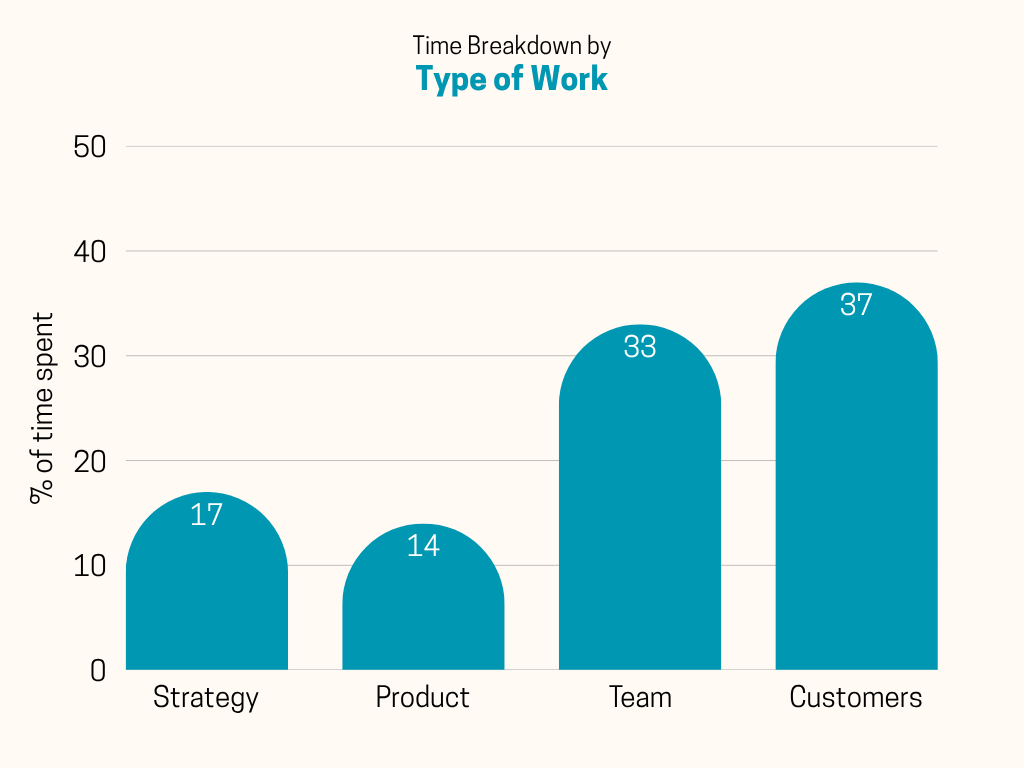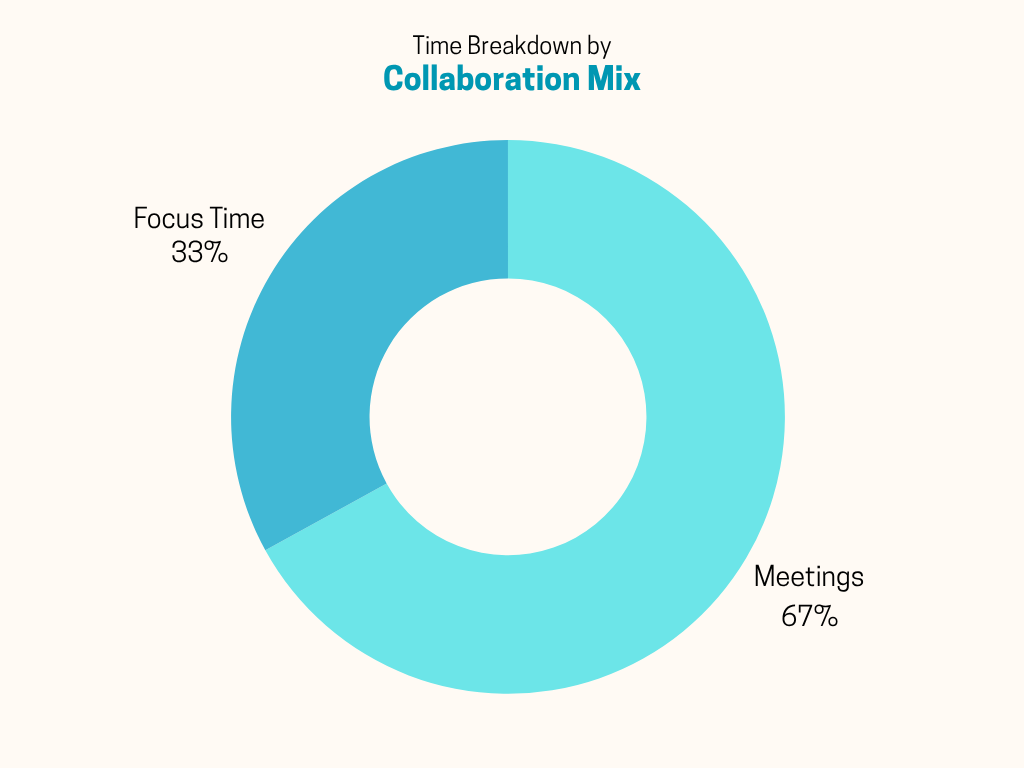2,000 meetings. 5,000 instant message conversations. 3,000 emails sent. That’s an average year for me as a product leader in tech. Like many of us, I live a high-calorie information diet.
Organizing my life and being a conduit for information has always been something I have gravitated towards intuitively. I’m not sure it helps at cocktail parties, but it did earn me the award of “Most likely to name his clipboard” in high school.
And here I am, a quarter century later, still living an organized life. I 💖📋.
In previous posts, I’ve discussed what tools I use to manage my time and my information diet of podcasts, Substacks, and AI digests. This post will look at how I spend my time at work - and how you, too, can easily do a calendar audit.
Strategy, Product, Team and Customers
For over a decade, this is how I’ve broken down how I spend my time. I organized my top level calendar audit around it, structure my extended leadership staff meetings around it, and often frame written notes to the team around these buckets. Here’s how my time breaks down into these for May 2025:
From most to least:
Customers: This bucket represents the time I spent hearing feedback from customers or advising them on their progress. I also include User Research & Data Science user analysis wallows. In May, I attended the Microsoft 365 Community Conference, so my time here was a bit higher than average as I spent a week off the typical routines and surrounded by our community.
Team: This bucket represents time focused on team culture, career advice and mentoring, all hands, and the systems and operations of the team. In May, it was performance management/commitment check-in time at Microsoft, so that meant more quality time preparing and delivering what we call Connects with my team.
Strategy: This bucket represents time spent on aligning and communicating the What and Why, allocation of resources, executives rhythms, and cross-org syncing. In May, I spent less time in this area than normal due to some big planning deliverables finishing up in April - but I still had an important review with a technical analyst firm to share my product’s multi-year vision.
Product: This bucket represents time spent in the depth of product tradeoffs, backlog reviews, and product play - using products and capturing things like friction logs. In May, I had less product reviews than average due to the conference and talent management processes taking up oxygen - yet I still found time to try out some emerging AI tools & give some detailed feedback to the team about some of our freshest live code.
Three Takeaways:
I’m happy that my number one bucket was time spent with customers. I have a friend who has a personal metric to “spend more time with customers than other company executives.” Check.
I’m surprised that my time on strategy was so little, especially the executive rhythms. While the cross-company executive rhythms take up a lot of energy, they take up less calendar time in the month than I thought.
I’m eager to increase my time on product. While a VP will often have less in this bucket than a GPM or individual contributor Product Manager, I especially want to spend more time in product play and bar setting.
How My Time Has Evolved Over My Career
It’s worth pointing out that how I’ve spent my time over the years has evolved. Here’s an idealized breakdown:
Here’s my advice for each stage:
Early Career PM: Go deepest in crafting product & learning from customers.
Senior PM: Start to incorporate some strategy, but with a deep focus still on core product making.
Principal PM: Strategy and core product tend to be more equally balanced (lots of x-team work!), and the time you invest in team culture starts to increase.
Frontline manager: You are pulled in many directions as you incorporate more of the team bucket yet still need to balance it all.
Group Manager: A bit more time for strategy, but still pulled in all four directions.
VP: Team and customers are the top drivers of time (30% each), yet when you look at strategy + product together, that combined bucket is still the dominant part of your time (40%). This gives the right space to senior leaders on the team yet keeps you close to what’s going on.
Collaboration vs. Focus Time
My job requires both dedicated focus (drafting whitepapers, using product, creating customer messaging) and a high amount of time aligning with others (editing work, bar setting, x-team syncing) - and I was curious about the breakdown on two dimensions. First, what is the raw breakdown between focus and meetings for me:
This feels about right to me. If I worked at a start up, the job is to grind out the sole product that the company was founded for - spending more time in focus mode. But that’s not my job - coordinating and syncing with others is a larger component of what I’m hired for.
On the other hand, I have a job where 100% of my time could be taken up by meetings, so starting at 0% focus is my anchor point and 33% focus time represents a lot of calendar protection.
We all know that focus is more than just brief periods of no meetings - it takes dedicated longer time to get into the flow. So I was curious to analyze meeting load:
Here is where I realized that there were only three days during the month where I had less than three hours of meetings/day (mostly No Meeting Fridays). Indeed, my most common format for a workday is over six hours of meetings/day. #thestruggleisreal
Diversity of Meeting Type
One last analysis I did for May was to look at the types of meetings I’m in, to see if it fit to my preconceived notions.
Here I found my month to be pretty balanced - a healthy amount of outside input and a good balance between working within the team and with others at the company. This analysis motivated me to take another look at my cadence of 1:1 meetings, as at 25% and no meeting Fridays, that means I spent one day/week in total on 1:1 meetings - it’s a place that can easily balloon.
And Now You Can Too….
I share this post not only because it’s an insightful look into how someone with my job spends their time, but also to motivate you to do your own calendar audit. My process is pretty informal:
I keep my calendar up to date so it’s easy to look back on the month.
Sometimes, I will add a dummy calendar item at the end of the day with notes on where I’ve spent focus time.
I create an Excel spreadsheet with one table per chart above - the rows are the days of the month and the columns are the buckets. It takes less than thirty minutes to tabulate my time into numbers on these tables.
It’s a super lightweight process yet it can drive a lot of intentionality and clarity. Even the act of knowing I’ll audit myself drives better decision making.
If you don’t have time for the full audit, try asking Copilot to analyze your month. It’ll provide a pretty good start, too.
If you try it out, let me know what you learn about yourself!







